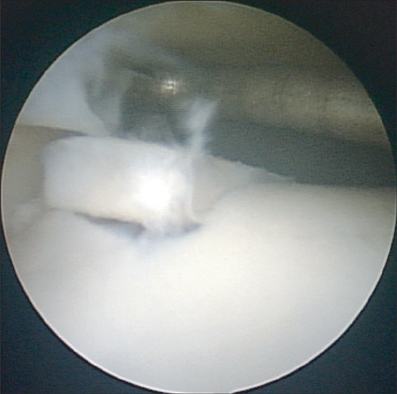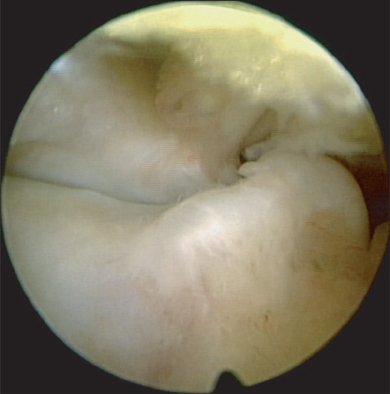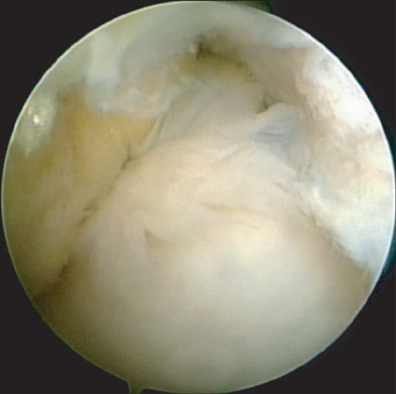Clin Orthop Surg.
2012 Dec;4(4):293-299. 10.4055/cios.2012.4.4.293.
Intra-articular Lesions in Chronic Lateral Ankle Instability: Comparison of Arthroscopy with Magnetic Resonance Imaging Findings
- Affiliations
-
- 1Department of Orthopaedic Surgery, Myongji Hospital, Kwandong University College of Medicine, Goyang, Korea. bladeplate@hanmail.net
- KMID: 1719297
- DOI: http://doi.org/10.4055/cios.2012.4.4.293
Abstract
- BACKGROUND
Chronic lateral ankle instability often accompanies intra-articular lesions, and arthroscopy is often useful in diagnosis and treatment of intra-articular lesions.
METHODS
Preoperative magnetic resonance imaging (MRI) examinations and arthroscopic findings were reviewed retrospectively and compared in 65 patients who underwent surgery for chronic lateral ankle instability from January 2006 to January 2010. MR images obtained were assessed by two radiologists, and the inter- and intra-observer reliability was calculated. American Orthopedic Foot and Ankle Society (AOFAS) and visual analogue scale (VAS) scores were evaluated.
RESULTS
Abnormalities of the anterior talofibular ligament (ATFL) were found in all 65 (100%) cases. In arthroscopy examinations, 33 (51%) cases had talar cartilage lesions, and 3 (5%) cases had 'tram-track' cartilage lesion. Additionally, 39 (60%) cases of synovitis, 9 (14%) cases of anterior impingement syndrome caused by osteophyte, 14 (22%) cases of impingement syndrome caused by fibrotic band and tissue were found. Sensitivity of MRI examination for each abnormality was: ATFL, 60%; osteochondral lesion of talus (OLT), 46%; syndesmosis injury, 21%; synovitis, 21%; anterior impingement syndrome caused by osteophyte, 22%. Paired intra-observer reliability was measured by a kappa statistic of 0.787 (95% confidence interval [CI], 0.641 to 0.864) for ATFL injury, 0.818 (95% CI, 0.743 to 0.908) for OLT, 0.713 (95% CI, 0.605 to 0.821) for synovitis, and 0.739 (95% CI, 0.642 to 0.817) for impingement. Paired inter-observer reliability was measured by a kappa statistic of 0.381 (95% CI, 0.241 to 0.463) for ATFL injury, 0.613 (95% CI, 0.541 to 0.721) for OLT, 0.324 (95% CI, 0.217 to 0.441) for synovitis, and 0.394 (95% CI, 0.249 to 0.471) for impingement. Mean AOFAS score increased from 64.5 to 87.92 (p < 0.001) when there was no intra-articular lesion, from 61.07 to 89.04 (p < 0.001) in patients who had one intra-articular lesion, and from 61.12 to 87.6 (p < 0.001) in patients who had more than two intra-articular lesions.
CONCLUSIONS
Although intra-articular lesion in patients with chronic lateral ankle instability is usually diagnosed with MRI, its sensitivity and inter-observer reliability are low. Therefore, arthroscopic examination is strongly recommended because it improved patients' residual symptoms and significantly increased patient satisfaction.
MeSH Terms
-
Ankle Joint/*pathology/*physiopathology
Arthroscopy/methods
Chronic Disease
Female
Humans
Joint Diseases/*diagnosis/pathology
Joint Instability/*diagnosis/pathology
Lateral Ligament, Ankle/pathology
Magnetic Resonance Imaging/methods
Male
Observer Variation
Pain Measurement
Retrospective Studies
Severity of Illness Index
Synovitis/pathology
Figure
Cited by 2 articles
-
Diagnosis and Comorbidity of Chronic Ankle Instability
Dongjun Ha, Duckhee Kim, Heuichul Gwak
J Korean Foot Ankle Soc. 2018;22(2):49-54. doi: 10.14193/jkfas.2018.22.2.49.Stress Radiographs under Anesthesia for Painful Chronic Lateral Ankle Instability
Jun Young Choi, Hee Chan Ahn, Myung Jin Shin, Jin Soo Suh
J Korean Foot Ankle Soc. 2017;21(1):12-16. doi: 10.14193/jkfas.2017.21.1.12.
Reference
-
1. Brostrom L. Sprained ankles. VI. Surgical treatment of "chronic" ligament ruptures. Acta Chir Scand. 1966. 132(5):551–565.2. Gould N, Seligson D, Gassman J. Early and late repair of lateral ligament of the ankle. Foot Ankle. 1980. 1(2):84–89.
Article3. Rubin DA, Tishkoff NW, Britton CA, Conti SF, Towers JD. Anterolateral soft-tissue impingement in the ankle: diagnosis using MR imaging. AJR Am J Roentgenol. 1997. 169(3):829–835.
Article4. Berndt AL, Harty M. Transchondral fractures (osteochondritis dissecans) of the talus. J Bone Joint Surg Am. 1959. 41-A:988–1020.
Article5. Ekstrand J, Tropp H. The incidence of ankle sprains in soccer. Foot Ankle. 1990. 11(1):41–44.
Article6. Baumhauer JF, Alosa DM, Renstrom AF, Trevino S, Beynnon B. A prospective study of ankle injury risk factors. Am J Sports Med. 1995. 23(5):564–570.
Article7. Gerber JP, Williams GN, Scoville CR, Arciero RA, Taylor DC. Persistent disability associated with ankle sprains: a prospective examination of an athletic population. Foot Ankle Int. 1998. 19(10):653–660.
Article8. Cass JR, Morrey BF. Ankle instability: current concepts, diagnosis, and treatment. Mayo Clin Proc. 1984. 59(3):165–170.
Article9. Freeman MA, Dean MR, Hanham IW. The etiology and prevention of functional instability of the foot. J Bone Joint Surg Br. 1965. 47(4):678–685.
Article10. Bosien WR, Staples OS, Russell SW. Residual disability following acute ankle sprains. J Bone Joint Surg Am. 1955. 37(6):1237–1243.
Article11. Jackson DW, Ashley RL, Powell JW. Ankle sprains in young athletes: relation of severity and disability. Clin Orthop Relat Res. 1974. (101):201–215.12. MacCartee CC Jr. Taping treatment of severe inversion sprains of the ankle: early return to functional activities. Am J Sports Med. 1977. 5(6):246–247.13. Lentell G, Baas B, Lopez D, McGuire L, Sarrels M, Snyder P. The contributions of proprioceptive deficits, muscle function, and anatomic laxity to functional instability of the ankle. J Orthop Sports Phys Ther. 1995. 21(4):206–215.
Article14. Staples OS. Result study of ruptures of lateral ligaments of the ankle. Clin Orthop Relat Res. 1972. 85:50–58.
Article15. Liu SH, Jason WJ. Lateral ankle sprains and instability problems. Clin Sports Med. 1994. 13(4):793–809.
Article16. Taga I, Shino K, Inoue M, Nakata K, Maeda A. Articular cartilage lesions in ankles with lateral ligament injury. An arthroscopic study. Am J Sports Med. 1993. 21(1):120–126.
Article17. van Dijk CN, Bossuyt PM, Marti RK. Medial ankle pain after lateral ligament rupture. J Bone Joint Surg Br. 1996. 78(4):562–567.
Article18. Kibler WB. Arthroscopic findings in ankle ligament reconstruction. Clin Sports Med. 1996. 15(4):799–804.
Article19. Hintermann B, Boss A, Schafer D. Arthroscopic findings in patients with chronic ankle instability. Am J Sports Med. 2002. 30(3):402–409.
Article20. Takao M, Uchio Y, Naito K, Fukazawa I, Ochi M. Arthroscopic assessment for intra-articular disorders in residual ankle disability after sprain. Am J Sports Med. 2005. 33(5):686–692.
Article21. Kim SH, Ha KI, Ahn JH. Tram track lesion of the talar dome. Arthroscopy. 1999. 15(2):203–206.
Article22. Oae K, Takao M, Naito K, et al. Injury of the tibiofibular syndesmosis: value of MR imaging for diagnosis. Radiology. 2003. 227(1):155–161.
Article23. O'Neill PJ, Van Aman SE, Guyton GP. Is MRI adequate to detect lesions in patients with ankle instability? Clin Orthop Relat Res. 2010. 468(4):1115–1119.
- Full Text Links
- Actions
-
Cited
- CITED
-
- Close
- Share
- Similar articles
-
- Arthroscopic Procedure in the Treatment of Chronic Lateral Ankle Instability
- Are Magnetic Resonance Imaging Findings of Ankle Instability Always Correlated with Operative and Physical Examination Findings?
- Reconstruction for Chronic Lateral Instability of the Ankle by Chen Method
- Chronic Lateral Ankle Instability: Efficacy of Combination of Ankle Arthroscopic Exploration and Modified Brostrom Operation
- Deltoid Ligament and Tibiofibular Syndesmosis Injury in Chronic Lateral Ankle Instability: Magnetic Resonance Imaging Evaluation at 3T and Comparison with Arthroscopy




